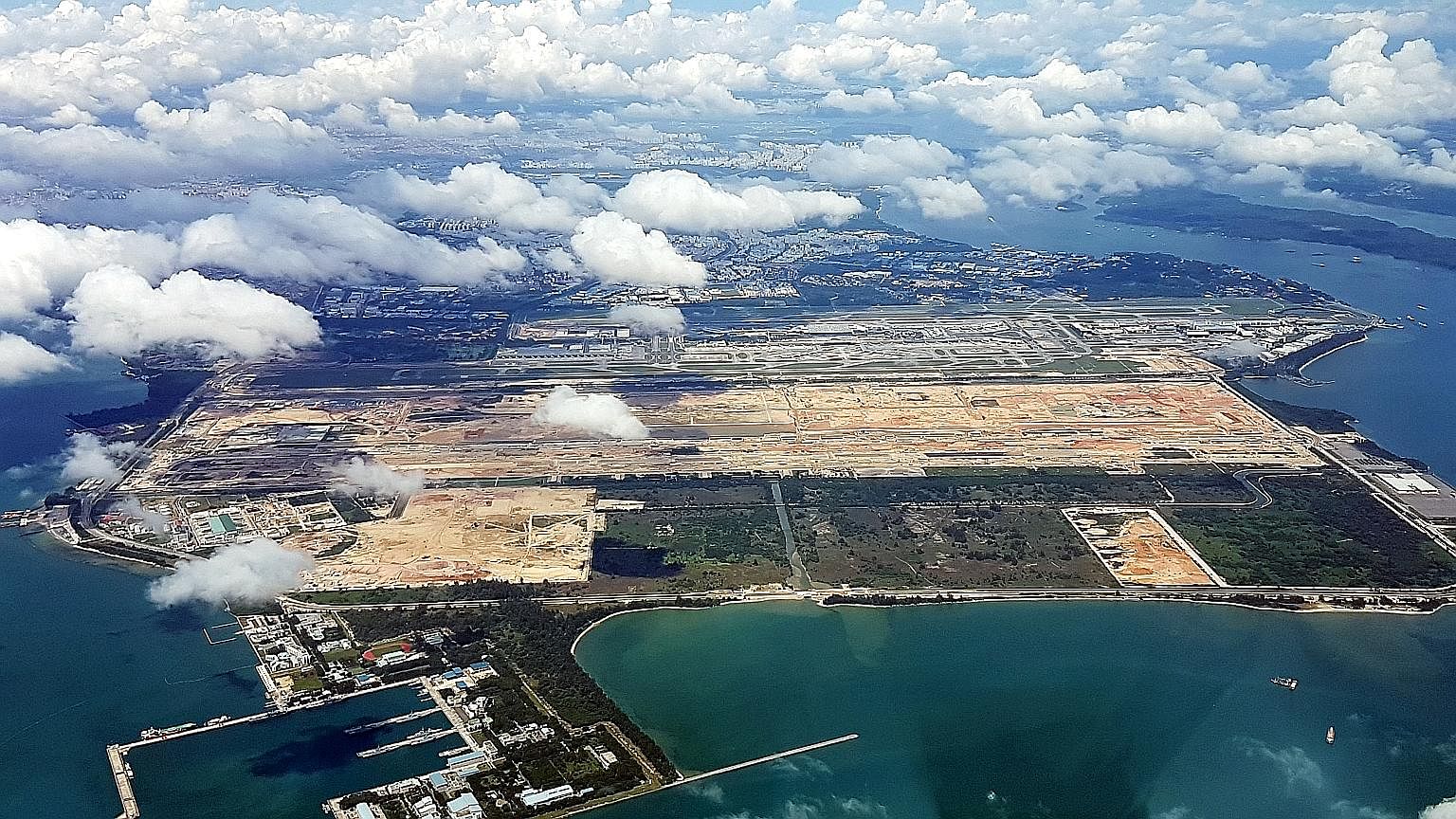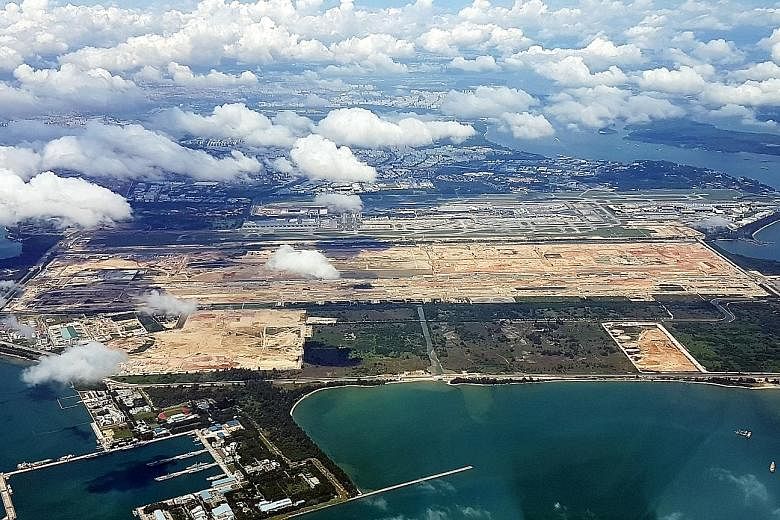With a price tag likely to run into tens of billions of dollars, who pays for Changi Airport's future Terminal 5 is a question that has already ruffled feathers.
This, even before an official announcement, expected over the coming months, is made.
The Changi East project includes T5, a mega passenger terminal, as well as major drainage and other ground works. Both the Government and the airport say it is a necessary investment.
With Changi on track to maximise the existing capacity at Terminals 1, 2, 3 and 4 before the end of the next decade, Singapore needs T5 to stay ahead in a very competitive race for premier air hub status.
Slated for completion around 2030, T5 is expected to eventually almost double Changi's handling capacity from 82 million passengers a year now, to 150 million.
Back to the billion-dollar question.
A Sunday Times report quoted the Ministry of Transport as saying that the Government will foot a "a large proportion" of the total bill for the Changi East project, given the strategic significance of the air hub.
Changi Airport Group - a corporate entity that operates the airport - will plough back "a huge part of our profits and future profits" into the development, its chief executive Lee Seow Hiang promises. For the financial year to the end of March 2017, CAG's profit after tax was nearly $660 million.

But travellers, airlines and other users will also have to chip in, the Government says, given the scale of the development and the need for public funds to also support healthcare, social services and other key national programmes.
Between 2007 and last year, government spending more than doubled, from $33 billion to $71 billion. Prime Minister Lee Hsien Loong has already said taxes will have to go up, though he has not confirmed when this will happen.
While dipping into the country's financial reserves - estimated at more than $1 trillion - to fund mega national initiatives is an option, it's one that the Government seems reluctant to exercise.
And so, like it or not, airlines and travellers will have to chip in to pay for the T5 project, possibly from as early as next year, The Sunday Times reported.
The revelation sparked much public discussion, with some netizens questioning the need for such a huge investment.
Others said the money spent on Jewel - a five-storey, mainly commercial development that will house about 300 shops and food and beverage outlets - should have been kept for T5. At $1.7 billion, Jewel, being built in front of T1 where an open-air carpark used to be, is a 51:49 joint venture between CAG and CapitaLand Mall Asia.
It opens in 2019 and aims, among other things, to boost Changi's attractiveness as a hub for transit travellers. Netizens who agree that Changi needs to continually expand still ask why the Government and CAG, which has been reporting healthy profits since its inception in 2009, cannot absorb the development costs.
And if there is really no choice but to raise passenger fees which are currently $34 for travellers departing from Changi Airport, surely the increase can wait until after T5 opens, they suggest.
Airlines are not happy either, though none would comment for the record.
The International Air Transport Association (Iata) - the voice for global carriers - has always opposed the idea of pre-funding, a document on its website explains.
Airport users should pay only for services and facilities they currently use, Iata says.
"Pre-funding is unreasonable as there is no guarantee that the airlines paying for future facilities today will still be using the service when the facilities become operational," the association argues.
It is also generally not applied in other transport sectors where either public funding through governments or private sector financing is available for sound business cases.
There are better and more cost-effective financing options such as external borrowing and institutional lending, Iata adds.
This is not the first time Changi's users are being asked to pre-fund expansion projects.
In April 2013, when the departure fee for travellers at Changi went up from $28 to $34, the airport said the increase was to help "fund new investments" and "partially cover the increase in aeronautical operating costs".
Two major projects were then in the pipeline - the construction of T4 which opened last month and the expansion of T1 which is ongoing. The T4 development cost just $985 million - a very small fraction of the total bill expected for T5.
Those who push for pre-funding for T5 will say that other airports have also recently introduced similar user charges.
Since last year, Hong Kong International Airport, which is building a third runway, has been collecting between HK$70 and HK$180 (S$12 and S$31) a passenger, depending on the class of travel and flight duration.
Last year, the airports in Dubai, United Arab Emirates and Doha, Qatar, which have ongoing expansion projects, introduced a departure tax for travellers which is the equivalent of $13. There may be more such examples but since when did Changi stop leading and start following?
The Singapore airport has always prided itself on being different, better than the rest. How else would an airport located on a tiny island with no domestic air travel market have achieved what Changi has in 36 years?
If pre-funding is a must, transparency is critical.
Be upfront about the total costs, explain where and how the money will be spent. Users should be told exactly how much the Government and CAG will pay.
To lessen the pain for airlines and travellers who do not end up using T5, tell them how the other terminals and facilities will be upgraded and improved.
The other big question is whether there should be equal pain for all.
Today, travellers departing Changi Airport pay $34 but the fee for transit passengers is just $6, while those flying from Seletar Airport pay $18.
The differentiation is sensible, pegged to the level of service provided and facilities offered.
If a T5 fee is imposed, it makes sense for those on long-haul flights, for example, to pay more since the amount will be a lower proportion of the total ticket cost.
Airport planners may also want to consider a lower charge for budget carriers, though this could be tricky because it assumes that full-service airlines make more money - which is not always true.
It would also help travellers and especially airlines, to better manage their costs, if any fees payable are staggered, with the amount increasing as the Changi East development progresses.
The bottom line - with competition heating up among airports in the region, decision-makers should be mindful that Changi's competitiveness is not compromised if users are made to pay for the T5 works.
Changi Airport would not be where it is if not for its home carriers and the airlines that fly here, as well as travellers and other partners. This is not the time to alienate them.


